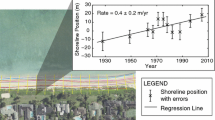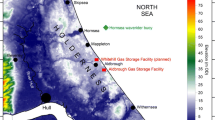Abstract
Changes of subaqueous topography in shallow offshore water pose safety risks for embankments, navigation, and ports. This study conducted measurements of subaqueous topography between Datong and Xuliujing in the Yangtze River using a SeaBat 7125 multi-beam echo sounder, and the channel change from 1998 to 2013 was calculated using historical bathymetry data. The study revealed several important results: (1) the overall pattern of changes through the studied stretch of the river was erosion–deposition–erosion. Erosion with a volume 700×106 m3 occurred in the upper reach, deposition of about 204×106 m3 occurred in the middle reach, and erosion of about 602×106 m3 occurred in the lower reach. (2) Dunes are the most common microtopographic feature, accounting for 64.3% of the Datong to Xuliujing reach, followed by erosional topography and flat river topography, accounting for 27.6% and 6.6%, respectively. (3) Human activities have a direct impact on the development of the microtopography. For instance, the mining of sand formed holes on the surface of dunes with lengths of 20–35 m and depths of 3–5 m. We concluded that the overall trend of erosion (net erosion volume of 468×106 m3) occurred in the study area mainly because of the decreased sediment discharge following the closure of the Three Gorges Dam. However, other human activities were also impact factors of topographic change. Use of embankments and channel management reduced channel width, restricted river meandering, and exacerbated the erosion phenomenon.
Similar content being viewed by others
References
Ashley G. M. 1990. Classification of large-scale subaqueous bed forms: A new look at an old problem. J Sediment Petrol, 1: 160–172
Best J. 2005. The fluid dynamics of river dunes: A review and some future research directions. J Geophys Res, 110: F04S02
Barnard P L, Erikson L H, Kvitek R G. 2011. Small-scale sediment transport patterns and bedform morphodynamics: New insights from high-resolution multibeam bathymetry. Geo-Mar Lett, 31: 227–236
Chen J, Wang Z B, Li M T, Wei T Y, Chen Z Y. 2012. Bedform characteristics during falling flood stage and morphodynamic interpretation of the middle-lower Changjiang (Yangtze) River channel, China. Geomorphology, 147-148: 18–26
Chen J Y, Yu Z Y, Yun C X. 1959. The development of the Yangtze River Delta (in Chinese). Acta Geogr Sin, 3: 201–220
Chen W M, Yang Z S, Cao L H, Guo Z G, Liu H, Du J P. 1993. Microgeomorphology on the subaqueous slope of the Changjiang River Delta (in Chinese). J Ocean Univ Qingdao, S1: 45–51
Chen Z Y, Zhou C Z, Yang W D, Wu Z G. 1986. Subaqueous topography and sediments off modern Changjiang Estuary (in Chinese). Donghai Mar Sci, 2: 28–37
Cheng H Q, Li M T, Zhou T Y, Xue Y Z. 2002. High-resolution microtopography movement in the Changjiang Estuary (in Chinese). China Ocean Eng, 20: 91–95
Franzetti M, Le Roy P, Delacourt C, Garlan T, Cancouët R, Sukhovich A, Deschamps A. 2013. Giant dune morphologies and dynamics in a deep continental shelf environment: Example of the banc du four (Western Brittany, France). Mar Geol, 346: 17–30
Guo X J, Cheng H Q, Mo R Y, Yang Z Y. 2015. Statistical characteristics and transport law of sand waves in the Yangtze Estuary (in Chinese). Haiyang Xuebao, 37: 148–158
Knaapen M A F. 2005. Sandwave migration predictor based on shape information. J Geophys Res, 110: F04S11
Knaapen M A F, Hulscher S J M H, de Vriend H J, Stolk A. 2001. A new type of sea bed waves. Geophys Res Lett, 28: 1323–1326
Li B, Yan X S, He Z F, Chen Y, Zhang J H. 2015. Impacts of the Three Gorges Dam on the bathymetric ecolution of the Yangtze River Estuary (in Chinese). Chin Sci Bull, 60: 1735–1744
Liu G P, Xu H, Bi J F. 2014. The analysis of sand mining and its influence to river channel evolution at Jiangsu segment in the Yangtze Estuary (in Chinese). Yangtze River, S2: 193–196
Lu X J. 2016. Research on the local scour at bridge piers in the tidal reach of the Changjiang River (in Chinese). Doctoral Dissertation. Shanghai: East China Normal University
Luo X X, Yang S L, Wang R S, Zhang C Y, Li P. 2017. New evidence of Yangtze delta recession after closing of the Three Gorges Dam. Sci Rep, 7: 41735
Luo Z, Cai B, Chen S L. 2016. Grain size and shape analysis of beach sediment using dynamic image analysis and comparison with sieving method (in Chinese). Acta Sediment Sin, 34: 881–891
Perillo M M, Best J L, Garcia M H. 2014. A new phase diagram for combined-flow bedforms. J Sediment Res, 84: 301–313
Qian N, Wang Z H. 2003. Mechanics of Sediment Movement (in Chinese).. Beijing: Science Press. 145–189
Qu G X. 2014. The characteristics and explanations of channel change in the Datong-Jiangyin reach of the lower Yangtze River: 1958–2008 (in Chinese). Doctoral Dissertation. Nanjing: Nanjing Normal University
Song C C, Wang J. 2014. Erosion-accretion changes and controlled factors of the submerged delta in the Yangtze Estuary in 1982–2010 (in Chinese). Acta Geol Sin, 11: 1683–1696
Schindler R J, Parsons D R, Ye L, Hope J A, Baas J H, Peakall J, Manning A J, Aspden R J, Malarkey J, Simmons S, Paterson D M, Lichtman I D, Davies A G, Thorne P D, Bass S J. 2015. Sticky stuff: Redefining bedform prediction in modern and ancient environments. Geology, 43: 399–402
Wang J, Liu P, Gao Z R, Bai S B, Cao G J, Qu G X. 2007. Temporal-spatial variation of the channel in Jiangsu reach of the Yangtze River during the last 44 years (in Chinese). Acta Geol Sin, 11: 1185–1193
Wang W W, Fan F X, Li C G, Yan J. 2007. Activity of submarine sand waves and seafloor erosion and deposition in the sea area to the southwest of Hainan Island (in Chinese). Mar Geol Quat Geol, 27: 23–28
Wang Z, Chen Z Y, Shi Y F, Li M T, Zhang Q, Wei T Y. 2007. The fluvial bedform and hydrodynamic controls along the middle and lower Yangtze River (from Wuhan to estuary) (in Chinese). Sci China Ser DEarth Sci, 37: 1223–1234
Wu J, Wang Y, Cheng H. 2009. Bedforms and bed material transport pathways in the Changjiang (Yangtze) Estuary. Geomorphology, 104: 175–184
Wu S H, Cheng H Q, Li J F, Zheng S W. 2016. Recent morphological variation and micro-topography features in North Channel of the Yangtze Estuary (in Chinese). J Sediment Res, 2: 26–32
Wu Z Y, Li J B, Jin X L, Shang J H, Li S J, Jin X B. 2014. Distribution, features, and influence factors of the submarine topographic boundaries of the Okinawa Trough. Sci China Earth Sci, 57: 1885–1896
Wu Z Y, Saito Y, Zhao D N, Zhou J Q, Cao Z Y, Li S J, Shang J H, Liang Y Y. 2016. Impact of human activities on subaqueous topographic change in Lingding Bay of the Pearl River estuary, China, during 1955–2013. Sci Rep, 6: 37742
Xia J Q, Deng S S, Lu J Y, Xu Q X, Zong Q L, Tan G M. 2016. Dynamic channel adjustments in the Jingjiang Reach of the Middle Yangtze River. Sci Rep, 6: 22802
Xu Q X. 2013. Study of sediment deposition and erosion patterns in the middle and downstream Changjiang mainstream after impoundment of TGR (in Chinese). J Hydroel Eng, 2: 146–154
Yang S L, Milliman J D, Li P, Xu K. 2011. 50000 dams later: Erosion of the Yangtze River and its delta. Glob Planet Change, 75: 14–20
Yang S L, Milliman J D, Xu K H, Deng B, Zhang X Y, Luo X X. 2014. Downstream sedimentary and geomorphic impacts of the Three Gorges Dam on the Yangtze River. Earth-Sci Rev, 138: 469–486
Yang S L, Xu K H, Milliman J D, Yang H F, Wu C S. 2015. Decline of Yangtze River water and sediment discharge: Impact from natural and anthropogenic changes. Sci Rep, 5: 12581
Zhong D Y, Wang Q X, Ding Y. 2005. Influence of sand wave migration on non-saturated suspended load transport in alluvial rivers (in Chinese). J Hydraul Engineering, 36: 1432–1438
Zheng S W, Cheng H Q, Wu S H, Liu G W, Lu X J, Xu W X. 2016. Discovery and implications of catenary-bead subaqueous dunes. Sci China Earth Sci, 59: 495–502
Zheng S W, Cheng H Q, Wu S H, Shi S Y, Xu W, Zhou Q P, Jiang Y H. 2017. Morphology and mechanism of the very large dunes in the tidal reach of the Yangtze River, China. Cont Shelf Res, 139: 54–61
Zhuang Z Y, Lin Z H, Zhou J, Liu Z F, Liu Y F. 2004. Environmental conditions for the formation and development of sand dunes (waves) in the continental shelf (in Chinese). Mar Geol Lett, 20: 5–10
Acknowledgements
We thank the two reviewers for their insightful comments and contributions. Thanks go to Wu Shuaihu, Lu Xuejun, Luo Zhang, Cai Bing, Luo Zhifa, Zhan Jian, Dong Weili and Xu Houyong. This study was financially supported by the National Natural Science Foundation of China (Grant Nos. 51761135023 & 41476075) and the China Geological Survey (Grant No. DD20160246).
Author information
Authors and Affiliations
Corresponding author
Rights and permissions
About this article
Cite this article
Zheng, S., Cheng, H., Shi, S. et al. Impact of anthropogenic drivers on subaqueous topographical change in the Datong to Xuliujing reach of the Yangtze River. Sci. China Earth Sci. 61, 940–950 (2018). https://doi.org/10.1007/s11430-017-9169-4
Received:
Revised:
Accepted:
Published:
Issue Date:
DOI: https://doi.org/10.1007/s11430-017-9169-4




